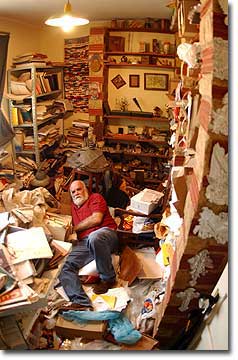Venice Biennale,
Sep 01, 2004 - Dec 01, 2004
Venice, Italy
26th International Biennial of Sí¢o Paulo, 2004
by Virginia Gil Araujo
Special Rooms
The special rooms dedicated to Brazilian art modernized the impact of conceptual art within the country. Veteran artists that began their activities in the 1970s were renowned in this edition of the biennial. Paulo Bruscky's atelier, featured as stage set, challenges the visitor to inventory all of the information an artist needs to collect and organize. Bruscky possesses one of the richest collections of contemporary international art, composed of over 70,000 items, over three thousand of which are pieces from the Fluxus movement, which the artist participated in. The stage, his mode of production and the unstable environment display the communicative character of his work.
Artur Barrio, another veteran artist, but born in Portugal, placed a "jangada" (a sail boat made from balsa wood, typical to the northeastern region of Brazil) that he acquired in the Brazilian city of Fortaleza in the bottom floor of the biennial, whose multicolor sail reached up to the second floor of the pavilion. According to Hug, the work was to function as a link between the Sculpture Park and the Painting Salon. A couch placed on top of sand near the boat invited the visitor to enjoy a brief contact with an imaginary reality. In the work "Imprópio para o consume humano" (Not for human consumption), the allegorical procedure of appropriation- in placing the balsa within the structure- gives the viewer an idea of Barrio's preference for the narrative, which he shows by displacing a fragment of an era and indicating the boat's path in the way he named two cities: Fortaleza-Lisbon. This inverts the route of the ship, which is meant to leave Portugal and sail along the route taken by the caravels (small, light sailing ships used in the 15th and 16th centuries) during the celebration of Brazil's 500th anniversary.
Performance and Site Specific Works
Contrary to the explicit function defined by Hug for Barrio's work, the jointly conceived and created works of Portuguese artists Rui Chaves ad Vera Mantero fared much better. Created specifically for the occasion and placed on the ramp joining the pavilion's first two floors, "Comer o Coracao" (Eat your Heart), integrates performance, installation and video. The art critic Alexandre Melo says of the work, "the title is a metaphor for the violence of the will when it rips drawings from shapes, or the lively presence of the body, and the unattainable completeness of a whole being. If Rui Chaves symmetrical towers evoke the absence of a body, demonstrated by the randomness of the movements choreographed by Vera Mantero, the impossibility of making a turn before the comfortably situated sculptures created specifically for this purpose, the end result does not conform to any expected reactions. Mantero's choreography is magnanimous in its expression and musicality. It reveals the limits and plastic possibilities of the body; the work excites the public lying in wait of an extraordinary experience.
One feels that the monotonous nature of the 26th International Biennial of Sí£o Paulo could not be avoided. Without the organization of a panel for discussion it runs the risk of being banal because no specific questions were asked and there was no debate over its meaning. The biennial should rethink this model, taking into consideration the historical experience of previous biennials. Considering the problems this edition of the biennial had, one can conclude that Kassel's Documenta offers more alternatives for contemporary art.
|









